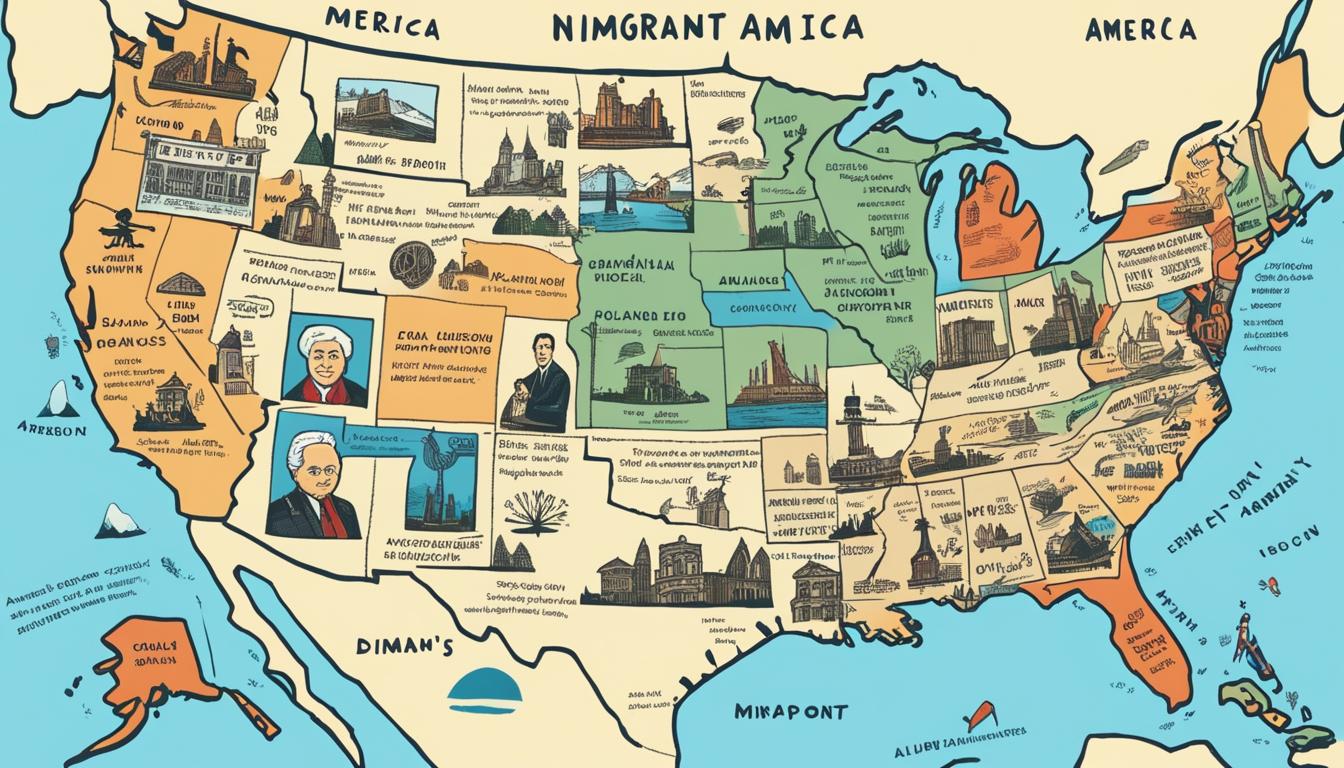In this article, we will delve into the book summary of “The Namesake” by Jhumpa Lahiri, an acclaimed novel that explores the themes of identity and cultural clash. Published in 2003, this captivating story takes readers on the journey of Gogol Ganguli, an Indian-American man who grapples with the challenges of reconciling his Bengali heritage with his American upbringing.
Key Takeaways:
- The Namesake by Jhumpa Lahiri delves into the complexities of cultural identity and the clash between different worlds.
- Gogol Ganguli’s journey serves as a representation of the immigrant experience, highlighting the challenges of assimilation and personal discovery.
- The significance of names plays a central role in shaping one’s sense of self and cultural identity.
- The novel explores the generational divide between immigrant parents and their American-born children, shedding light on the conflicts and tensions that arise.
- Jhumpa Lahiri’s writing style captivates readers with its meticulous attention to detail, offering a tangible exploration of characters and their experiences.
Overview of The Namesake
The Namesake, published in 2003, is a captivating novel that delves into the immigrant experience, generational divide, and cultural identity. Written by the acclaimed author Jhumpa Lahiri, the book offers a nuanced portrayal of the challenges faced by immigrants and their descendants in the United States.
The novel follows the protagonist, Gogol Ganguli, as he navigates the complexities of his personal identity while simultaneously grappling with the expectations and traditions of his Bengali family. Lahiri’s storytelling shines a light on the cultural clash between Gogol’s Indian heritage and his American upbringing, showcasing the intricate web of emotions and struggles that come with balancing multiple worlds.
The Namesake explores the immigrant experience in a profound and thought-provoking manner, shedding light on the complexities of cultural assimilation and the ever-evolving definition of home. Lahiri’s writing captures the emotional and psychological journey of Gogol as he tries to find his place in society, highlighting the generational divide and the universal quest for a sense of belonging.
This image visually represents the immigrant experience central to The Namesake and further emphasizes the novel’s exploration of cultural identity.
Plot Summary
The plot of The Namesake revolves around the life of Gogol Ganguli, an Indian-American man who was born and raised in the United States. The novel explores Gogol’s journey of self-discovery and the impact of his unusual name, which is a reflection of the cultural clash between his Bengali heritage and American upbringing. Throughout the story, Gogol grapples with his personal identity, trying to navigate the complexities of his dual heritage.
From a young age, Gogol feels the weight of his name, which sets him apart from his American peers and highlights the clash between his cultural background and the world he grows up in. As he grows older, Gogol tries to forge his own path and establish his sense of self. He embraces the American lifestyle and distances himself from his Bengali roots, even legally changing his name to Nikhil during his college years.
“That’s the whole point, really, of naming a child, isn’t it? So he’ll fit into a mold, a tradition, a family, a home,” Ashima, Gogol’s mother, reflects in the novel.
However, Gogol’s journey of self-discovery is not without its challenges. Despite his efforts to escape his cultural heritage, he realizes that his roots are an integral part of his identity and that he cannot deny his heritage forever. As he navigates various relationships and encounters different cultures, Gogol begins to question the choices he has made and the sacrifices he has endured to fit in.
In the midst of personal turmoil and self-reflection, Gogol gradually comes to understand that his name, although unusual and burdensome at times, holds a deep significance. It represents his unique cultural heritage and serves as a reminder of his family’s history and traditions. Through the exploration of his personal and familial connections, Gogol ultimately embraces his dual identity, finding a delicate balance between his Bengali roots and his American life.
References:
- Jhumpa Lahiri, The Namesake (New York: Houghton Mifflin, 2003).
Next, we will delve into Gogol’s early life in America, exploring the challenges he faces within his Bengali-American family and his struggle with personal identity.
Gogol’s Early Life in America
The novel begins by narrating the early days of the Ganguli family in America. Ashoke, Gogol’s father, moved to Boston after surviving a train accident in India. Ashima, Gogol’s mother, later joins Ashoke in Boston after their arranged marriage. The couple faces challenges in raising their children with a blend of their Bengali cultural practices and the desires of their American-born children.
The book highlights the difficulties faced by Gogol in navigating his cultural identity and the conflicting expectations placed upon him.
The Significance of the Name Gogol
The central premise of the novel revolves around the name Gogol, which is given to the main character by his parents. The name comes from Ashoke’s near-death experience on a train while reading the works of Nikolai Gogol. Gogol’s struggle with his name represents the larger theme of cultural clash and the challenges faced by individuals caught between two worlds. The name becomes a symbol of his identity crisis and influences his journey throughout the novel.

Throughout the novel, the name Gogol serves as a constant reminder of the cultural clash Gogol experiences as an Indian-American. It represents the conflict between his Bengali heritage and his American upbringing. Gogol feels burdened by a name that he does not fully identify with, and it becomes a source of confusion and turmoil for him.
“Gogol is not a name,” he says quietly. “It’s the stupid pet name you guys gave me as a baby.”
Gogol’s struggle with his name goes beyond a mere dislike for it. It delves into the heart of his identity crisis and the challenges he faces in reconciling his dual heritage. The name becomes a tangible symbol of the clash between his Indian roots and his desire to assimilate into American society.
The significance of the name Gogol highlights the complex nature of cultural identity and the impact of society’s expectations on individuals. Gogol’s journey towards self-acceptance and understanding is intricately tied to his relationship with his name, and it ultimately leads him to question the importance of names in shaping one’s sense of self.
Gogol’s Journey of Self-Discovery
As Gogol grows up, he grapples with his identity and tries to establish a sense of self. He experiments with different versions of his name, eventually legally changing it to Nikhil during his college years. The name change reflects his desire to distance himself from his Bengali heritage and forge a new identity.
However, Gogol’s journey of self-discovery is not without challenges, as he realizes that his roots and heritage are an integral part of his identity.
Relationships and Cultural Expectations
The Namesake delves into the complexities of relationships and the impact of cultural expectations on individuals. Gogol’s romantic relationships, particularly with Moushumi, highlight the challenges of reconciling cultural expectations with personal desires.
“Love, in all its mysterious forms, requires compromise, understanding, and an acceptance of cultural differences. The characters in The Namesake navigate these complexities with varying degrees of success, shedding light on the struggles and conflicts that arise due to cultural differences.”
The novel also explores the generational divide between immigrant parents and their American-born children. It sheds light on the clash of cultural expectations and the tension that arises between traditional values and the desire for individual freedom and self-expression.

The relationships depicted in The Namesake exemplify the challenges faced by individuals who are torn between cultural expectations and their own desires. It invites readers to reflect on the intricate dynamics of relationships and the impact that cultural identity can have on personal connections.
Themes of Assimilation and Belonging
The Namesake tackles the intricate themes of assimilation and the universal quest for a sense of belonging. Jhumpa Lahiri delves deep into the challenges faced by immigrants and their descendants as they navigate the complexities of integrating into a new culture while preserving their cultural identity. The novel explores the ever-evolving definition of home and the tension between embracing one’s heritage and assimilating into a new society. It raises profound questions about cultural identity and the arduous journey of finding a true sense of belonging.
Adaptation into a Film
The Namesake, Jhumpa Lahiri’s captivating novel, was brought to the big screen in 2006 through a film adaptation directed by Mira Nair. Like the novel, the film resonates with audiences by portraying the universal quest for belonging and the challenges of cultural assimilation. Nair’s adaptation skillfully brings Lahiri’s exploration of identity to life on the screen, capturing the emotional journey of Gogol and his search for a sense of self.

The Namesake film beautifully captures the essence of Lahiri’s novel, immersing viewers in the poignant tale of Gogol Ganguli. Through visually stunning scenes and powerful performances, the film delves into the complex themes of cultural identity and the universal desire to find one’s place in the world. Nair’s directorial vision enhances the emotional impact of the story, making it a must-watch for both fans of the novel and newcomers alike.
“The film adaptation of The Namesake allows audiences to experience the profound journey of Gogol in a whole new way. It takes Lahiri’s exploration of identity and cultural assimilation to the screen, captivating viewers with its powerful storytelling and visual aesthetics.” – Film Critic
The film adaptation of The Namesake further showcases Mira Nair’s talent as a director, combining her unique storytelling approach and visual flair to create a captivating cinematic experience. Nair’s deep understanding of Lahiri’s work shines through in her adaptation, effectively conveying the struggles, hopes, and introspection of the characters.
Mira Nair’s film adaptation of The Namesake strikes a universal chord, resonating with audiences worldwide by illuminating the challenges faced by individuals in their pursuit of belonging and self-discovery. Through her masterful direction, Nair brings to life the profound themes of Lahiri’s novel, making the film a powerful exploration of identity and the human experience.
Critical Reception and Impact
The Namesake, written by Jhumpa Lahiri, garnered widespread critical acclaim for its nuanced portrayal of the immigrant experience and cultural representation. Lahiri’s impeccable writing style and her meticulous examination of identity resonated deeply with both readers and critics alike.
The novel, with its compelling narrative and thought-provoking themes, sparked important conversations about cultural assimilation, generational differences, and the profound impact of names on shaping one’s sense of self. Lahiri’s work continues to have a lasting impact on the literary landscape, paving the way for diverse and authentic storytelling.
A critic from The New York Times described The Namesake as “a stunning exploration of the immigrant experience, presenting a tapestry of cultural identities that challenges and captivates the reader.”
Lahiri’s ability to capture the complex nuances of cultural assimilation and the challenges faced by individuals caught between two worlds captivated readers around the globe. The novel’s success not only lies in its compelling narrative, but also in the depth of its cultural representation, which resonated with diverse audiences.
By shedding light on the universal quest for belonging and the significance of personal and familial expectations, Lahiri’s work opened doors for more diverse voices and authentic storytelling. The Namesake stands as a testament to the power of literature in illuminating the human experience and fostering understanding across cultures.
Connections to Other Works
The Namesake shares thematic connections with other literary works that explore the immigrant experience and cultural exploration. It can be compared and contrasted with books like Us & Them and Exit West, which delve into similar themes of assimilation, identity, and belonging.
The similarities and differences between these works highlight the variations in storytelling approaches and shed light on the diverse experiences of immigrants and their descendants.
Reflections on Writing and Style
Jhumpa Lahiri’s writing style in The Namesake is characterized by its seriousness and attention to detail. The author’s meticulous approach and inclusion of minutiae often result in historically accurate scenarios but may also overwhelm readers with excessive information. Lahiri’s exploration of her own writing process and her experiences with writing in Italian offer insights into her approach to storytelling and the importance of language in shaping narratives.
Conclusion
In conclusion, The Namesake by Jhumpa Lahiri is a captivating novel that delves into the complexities of cultural identity and the immigrant experience. Through the compelling journey of Gogol Ganguli, Lahiri explores the challenges faced by individuals caught between two cultures, as they navigate the clash between their heritage and the society they inhabit.
Lahiri’s storytelling is both insightful and thought-provoking, shedding light on the universal quest for belonging and the impact of personal and familial expectations on one’s sense of self. The novel resonates with readers, inviting them to reflect on their own experiences of identity and the intricate balance of embracing one’s roots while assimilating into a new culture.
With her masterful prose and attention to detail, Jhumpa Lahiri has created a work that not only captures the immigrant experience but also serves as a reflection of the broader human experience. The Namesake continues to be celebrated for its exploration of cultural identity and the complexities of navigating multiple worlds, cementing Lahiri’s status as a renowned author in contemporary literature.
FAQ
What is The Namesake about?
The Namesake is a novel written by Jhumpa Lahiri that explores the journey of Gogol Ganguli, an Indian-American man, as he navigates his identity and grapples with the cultural clash between his Bengali heritage and American upbringing.
When was The Namesake published?
The Namesake was published in 2003.
What are the main themes of The Namesake?
The main themes of The Namesake include cultural identity, assimilation, and the significance of names in shaping one’s sense of self.
Who is the author of The Namesake?
The author of The Namesake is Jhumpa Lahiri.
Was The Namesake adapted into a film?
Yes, The Namesake was adapted into a film in 2006, directed by Mira Nair.
What is the significance of the name Gogol?
The name Gogol, given to the main character by his parents, represents the larger theme of cultural clash and the challenges faced by individuals caught between two worlds.
How does Gogol’s journey of self-discovery unfold in the novel?
Gogol experiments with different versions of his name and eventually legally changes it to Nikhil during his college years, reflecting his desire to distance himself from his Bengali heritage and forge a new identity.
What are the main themes explored in The Namesake?
The Namesake delves into themes such as assimilation, the universal quest for belonging, and the challenges faced by immigrants and their descendants as they navigate two distinct cultures.
How was The Namesake received by readers and critics?
The Namesake received critical acclaim for its nuanced portrayal of the immigrant experience and cultural representation. Jhumpa Lahiri’s writing style and exploration of identity resonated with readers and sparked important conversations about cultural assimilation and generational differences.



